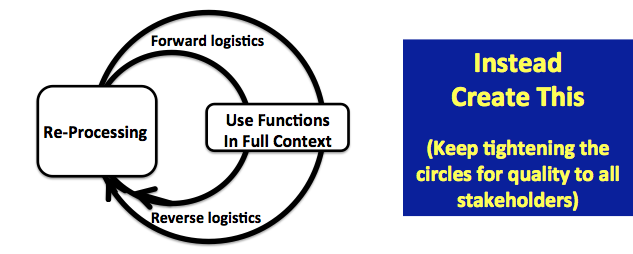Quality over quantity is one of six “principles” of Compression Thinking. In that context, quality is capability for all stakeholders in a process to live well using a minimum of resources over an indefinite future – a definition broader than that in general use.
From a strategic view, quality is a strategic attribute of a company or any organization. It becomes a guiding principle of processes in which the company engages. Such a broad interpretation contrasts with using the term quality to imply much narrower concepts. In everyday use “quality” means whatever a speaker wants it to mean, depending on its context.
An example of subjective quality is music attracting one listener, but offending others. By contrast, qualities of a piston ring (sealing ability; durability) can be objectively tested. Industry commonly differentiates between design quality and production quality conforming to design even if the design is shoddy. Of course, using no measurements at all, customers often opine whether something meets their quality needs and expectations. (A prior update illustrated people preferring quality food over less healthy fare if they can afford it.) Finally, an example of systemic quality is an environmentalist defining the quality of a nature preserve as the richness of its biodiversity and whether it is increasing or decreasing.
As a principle of Compression, “quality” refers to quality of a total system usually bigger than a company, in contrast with “output quality” — good enough to “capture market share,” thus increasing quantity. A couple of diagrams may help convey systemic quality:
Fig. 1. Business Seen as Center of a “Bow Tie” Logistics System
A system of fragmented parts is little more than the sum of its parts, even if tied together by a logistics system or a complex information system. First, every business will draw a different bow tie with itself at the center. Then the fragments tend to have conflicting objectives, which inclines them to win/lose strategies. That works against improvement of a total system. Quality effects on far-removed stakeholders are easily overlooked. Finally, a fragmented system perpetuates thinking that bigger, global, and cheaper is better, and “growth” is an unquestioned criterion of each fragment’s success.
Fig. 2. Business Embedded in a Learning Loop System
Many environmentally concerned people promote a circular economy, going local and abiding by the Rs, like re-use, re-manufacture, and recycle. Farmer’s markets are a popular example. Among industrial pioneers are carpet companies that recycle nylon carpet.
However, a learning system implies more than circular logistics if participants address the quality of the total system. Obviously, smaller learning-loops should more easily see effects on all stakeholders than large systems, thus considering long-term system effectiveness, not just simplifying fragments to better local efficiency. This view of things provokes questions rarely asked by companies fearful of disrupting revenue streams. In a circular learning loop system, each company has to be clued into the system and be flexible enough to improve quality to all stakeholders.
That kind of transformation would be a business revolution.
Take carpet for example. What would be the mission of a learning loop system in which it might be embedded? Possibly something like serving the needs of each building, its occupants, its neighbors, and all stakeholders working with the building; might call it a building maintenance improvement network. Any name seems awkward; we’re not used to thinking in a big integrative fashion.
But carpet company leaders, if they make that mental leap, ask questions not deeply considered before. For example, why have any floor covering at all? What is its purpose? Can it improve the life and health of the building as well as its occupants? Does it integrate with systems for cleaning and maintenance? How long should it last? Does it help keep the building resilient to fire, flood, or mayhem? Can it be easily changed or reused when building uses change? And of course, what is its environmental footprint, and what effect does it have on the footprint of the building?
(Two prior updates have been case studies about a learning loop system something like this for cleaning buildings, and the role of a company involved, PortionPac Chemical.)
Once determined to make a strategic shift toward a learning loop system, leadership has to become engaged developing the people and the organization to function in this way. We have labeled that a “Vigorous Learning Organization.” To fully embrace a different concept of business, the major challenge is leadership for transformation – transforming the business, and even transforming its values. That is a subject for the next newsletter.
None of us whiffle through such momentous change by reading articles. That’s why we are inviting a few people to participate with us in a Learning Lab Dialog series. You too can sign up and dig in. A description is below/above.


